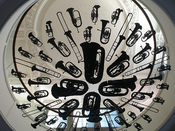The Battle for Superiority
With the invention of metal, a truly powerful dispute arose. Some may call it "the war" or "the battle", but either way, it lurks in the souls of every musician. Every opportunity to present this issue is leapt upon. From the high-school acoustic-incompetent band room, to the finely tuned symphony halls, the controversy that launched so long ago rages on. The question is, which is truly superior, woodwinds or brass?
The woodwind instruments of the world have sustained a place in the world for many generations of human existence. Just about every woodwind, like the name implies, in one era or another, evolved from being made of wood. The flute is the only instrument of the woodwind type that does not use a reed, but all of the rest of the instruments use a small sliver of bamboo that vibrates to create the sound that it emanates.
Many of the traits that describe the woodwind faction of the ensemble may be understood through questioning those who involve themselves in this subject.
The true essence of the woodwind instrument can only be heard depending on the player's ability to play the instrument and the efficiency of the instrument. For example, one fact about woodwinds that may affect the competence is the fact that all of the instruments have many keys and pads. Many keys and pads can provide for a slow learning process. Also, this fact causes many fingerings of certain notes to be extremely complicated. These many obstacles in the woodwinds' design provide for a more difficult learning experience while playing the instrument. Depending on the player's experience, the efficiency may be affected by the lack of interest in the instrument. In real life, many Royal High School woodwind players quit being in band because of...

![Child playing with toy soldiers and trumpet. [front]](https://s.writework.com/uploads/8/82753/child-playing-toy-soldiers-and-trumpet-front-thumb.jpg)

Woodwinds vs. Brass
This is a fine essay and it contains a good deal of valuable information. Were I to edit it, I would take out the criticism of the middle school band teacher, and I would drop the notion that there is some melodramatic conflict between winds and brass.
0 out of 0 people found this comment useful.